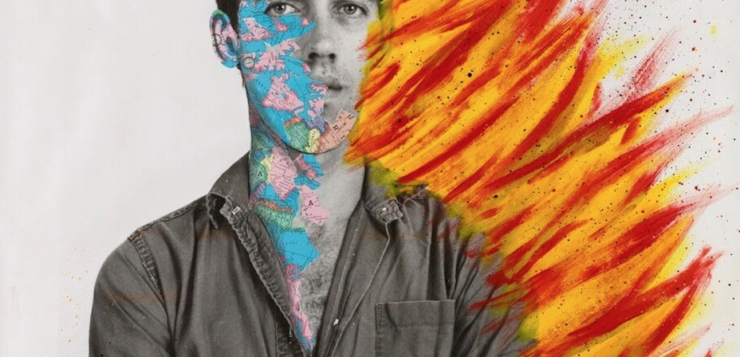WOJNAROWICZ
F–k You F-ggot F–ker
Directed by Chris McKim
Hobo Camp Films,
World of Wonder Productions
ALTHOUGH David Wojnarowicz has been the subject of many essays, studies, and an excellent biography by Cynthia Carr, Chris McKim’s film is the first feature-length documentary to examine his life and work. The film does not have a narrator but makes extensive and effective use of the many tape journals that the artist recorded starting in 1976. The result is an audio collage that tells his story along with images of his work, and of the artist himself, that fade in and out in kaleidoscopic fashion.
In these recordings, we hear Wojnarowicz in his own voice. He articulates his life’s complexities and contradictions and serves as the narrator of his own story, a historian of the self. At times, he reaches backward to interpret and evaluate his own past—notably, a childhood whose main feature was survival, in which all self-expression was prohibited. Then there’s the Wojnarowicz who is navigating the often complicated goings-on of the present, in which questions of survival—as a homosexual, as an artist, as someone with AIDS—mix with a boundless rage at the “diseased society” around him. In this way, the film blows away the sands that can fall upon artists and their work over time, bringing them back to life with a spectacular immediacy.

In the film, we watch as Wojnarowicz’ worldview, artistic vision, and commercial success expand. At age 26, he says in his journal: “Thinking about the effect of people on people, wondering if any of it’s meaningful, if it’s futile.” And the startling realization that there is something of worth in the art he is making—the images and stories are “my life and I don’t owe it to anybody to distort that just for their comfort.” The early paintings, the film asserts—many of which feature militaristic imagery—record both a personal history and a vision of mankind on the precipice of self-annihilation. This was angry, cathartic art, a way for Wojnarowicz to prove “my own existence” to himself and to the world. He believed in the power of individuals to make a difference in the larger political system: “When people put themselves on the line in their work,” he says in the film, “they apply a tiny amount of pressure against the system of control that would willingly jump into fascism if there wasn’t enough pressure on its throat.”
While Wojnarowicz’ own words remain at the forefront, the film’s chorus of voices multiplies to include friends like Fran Lebowitz, Gracie Mansion (his first gallerist), and eventually Tom Rauffenbart, who was Wojnarowicz’ partner when he died in 1992. Much attention is justly paid to his relationship with photographer Peter Hujar—perhaps the most important person in Wojnarowicz’ adult life—who encouraged him to pursue his artistic vision, who shared his own “desperate and confused” outlook on life, “minus that one seed of hope that I have in me.” (Here the film turns to recordings from Wojnarowicz’ answering machine, highlighting Hujar’s playful, affectionate, and intimate messages.)
Against the backdrop of a bustling early-’80s East Village art scene and a city in decay, the film also charts the era’s emerging queer sensibility (and its punk origins), which art critic Carlo McCormick characterizes in the film as an attitude of “I’m not gay as in I love you, I’m queer as in fuck off.” Wojnarowicz embodied this sensibility, but his goal was never subversiveness for its own sake. He was angry, and increasingly so as AIDS ravaged the city and his community, killing Hujar in 1987. Even as he became more famous in the mainstream art world, he was disgusted by the dirty money that was finally feeding him. He found no gratification in being “seen” by the homogeneous, commodified, commercial art establishment. He remained, as ever, in search of the “odor, [the]stink”—i.e., the human—in his art. He strove unrelentingly to make work that challenged the “pre-invented existence,” as he called it, that we are born into, and the white, “one-tribe nation” that we inhabit.
In the film, photographer Nan Goldin says of Wojnarowicz: “There aren’t such intense people in the world anymore.” McKim’s documentary reveals a life molded from this intensity. “The imagination,” Wojnarowicz says matter-of-factly, “is the key to breaking through the borders of countries, [through]existing structures of government. The work that anybody does as an artist, if it doesn’t reflect resistance, then we’re helping a system of control become more perfect.”
Giancarlo Latta is a violinist, writer, and composer based in New York.






